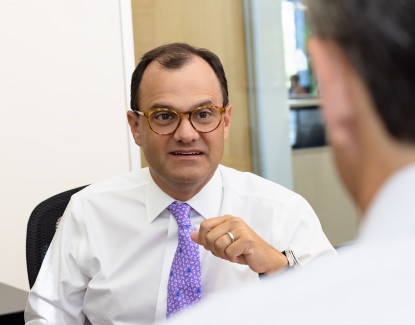A Deep Dive Into the Fund's Concentrated Portfolio
In the following commentary, the Portfolio Managers of the Hennessy Focus Fund provide an update on the holdings, including which companies might benefit the most as the Federal Reserve ceases its rate hikes. The team also discusses opportunities in the growth of artificial intelligence, its Financials holdings, and Warren Buffett’s new position in NVR.
-
 David Rainey, CFACo-Portfolio Manager
David Rainey, CFACo-Portfolio Manager -
 Ira Rothberg, CFACo-Portfolio Manager
Ira Rothberg, CFACo-Portfolio Manager -
 Brian Macauley, CFACo-Portfolio Manager
Brian Macauley, CFACo-Portfolio Manager
What are the earnings growth rates and valuation for the Fund vs. the Russell 3000® Index as of the end of July 2023?
As of July 31, 2023, the Fund traded at 19.1x our estimate of 2023 operating earnings, which compares to 20.4x for the Russell 3000® Index (a 6% discount). The Fund is trading at 16.6x our estimate of 2024 operating earnings, which compares to 18.1x for the Russell 3000® Index (an 8% discount).
We believe the Fund will grow operating earnings by 16.6% in 2024 versus 2023, compared to 12.9% growth for the Russell 3000® Index.
As the Federal Reserve ceases its interest rate increases, which holdings could benefit the most?
While inflation has moved down considerably from its peak, we think the Fed will need to see incoming economic data that is supportive of further progress before it ceases increases in the federal funds rate. When the Fed becomes confident that inflation is moving sustainably down toward its 2% goal, we believe the Federal Open Market Committee will begin to cut rates. We believe that long-duration equities, i.e., stocks that are expected to generate the bulk of their cash flow in the more distant future, will benefit the most from lower inflation and lower interest rates.
Two of our holdings with significant real estate exposure, Brookfield Corporation and American Tower, hold long-duration assets and are able to employ meaningful financial leverage because of the consistency of their cash flow. The market value of the assets they hold is highly sensitive to long-term interest rates and lower interest rates would allow their assets to be financed at a lower cost. We believe both companies are poised to see significant valuation multiple expansion if incoming data suggests inflation is on a path toward the Fed’s target.
How could American Tower as well as other holdings benefit from the growth of AI?
American Tower (AMT) benefits in three key areas:
1. AMT should benefit through its ownership of CoreSite and its 28-carrier neutral, colocation data centers. Leasing revenue at CoreSite was up 9% in the first half of the year driven by strong demand for compute and storage space that supports AI initiatives, public and hybrid cloud networks, and continued outsourcing of data operations by businesses.
2. AMT’s core cell tower business has seen a record of new leasing activity in the last 12 months as mobile network operators in the U.S. add 5G network sites to support the 20-30% annual growth in wireless data demand. This demand is fueled by the increasing processing power and utility of modern smartphones enabled by leading edge semiconductor chips which manage signal strength, power, and connectivity.
3. Companies are just now beginning to leverage advances in networking (5G and fiber), algorithms and data centers “at the edge” of the network to run AI workloads closer to where smartphones, apps, and other devices reside. This leads us to believe that in the next three to five years, AMT will see continued strength in its CoreSite business as well as new revenue opportunities from renting data center space on land under its cell sites. We expect the tenants to be hyperscale internet companies and large corporations looking to lower cloud computing costs and reduce latency by feeding real-time data directly back into AI models hosted at the tower site.
In addition to AMT, several of our other holdings are impacted as well. Applied Materials sells sophisticated semiconductor manufacturing tools to fabs and foundries. Brookfield is teaming with Intel to finance its new chip plants in Arizona. CDW is working with global clients every day to implement the public and hybrid cloud network backbones needed to harness our digital transformation. Cogent carries a quarter of the internet’s data traffic, SS&C is implementing AI and machine learning as it rolls out over 2,000 new digital workers this year, and AST benefits from the decline in both the size and cost of semiconductors in its nascent LEO (low-earth orbit) satellite business.
Would you please discuss your current investment case for SS&C.
SS&C provides software and solutions to service customers in the financial services and healthcare industries. The company’s addressable markets include fund administration, investment management and transfer agent services, trading, accounting, client and regulatory reporting as well as more recently pharmacies and pharmacy benefit managers.
SS&C benefits from important competitive advantages. Its software becomes embedded in customer workflows and tends to have limited competitive substitutes at the large scale in which it operates. Many of its software sets are interoperable and increasingly cloud native, leading to high switching costs, decent pricing power as well as a 96%-plus revenue retention rate, up a point over the last four years. This position is further enhanced by important intellectual property and the research and development scale that comes from being an industry leader.
However we have been disappointed with low single digit organic growth rates over the last few years. While Covid impacted SS&C’s employee work routines and resulted in a reduced real estate footprint and savings in this regard, it also disrupted the pace and closing of new pieces of business that fuel organic growth; today many customers continue to delay important software and outsourcing projects. At the same time, wage inflation has led to employee costs outpacing revenue growth and crimping operating margins. But the wage pressures are abating and operating margins are recovering.
Accretive acquisitions were also part of the long-term story but have slowed since the 2018 banner year. Acquisition multiples remain too high for CEO Bill Stone who owns 14% of the stock and takes an owner’s mentality to acquisition analysis. But over time, we expect multiples to come down allowing SS&C to become more active.
We continue to like the stock and the story. SS&C has a large growth opportunity in front of it; today the company has approximately a 5% share of the estimated $100bb+ annual spend (software and services) in the U.S. financial record-keeping market and even less of the equally sized international market. We first purchased shares at~13x forward earnings. Today we estimate SS&C shares are trading ~11.3x this year’s cash earnings and ~10x 2024 cash earnings. This is inexpensive for a company trading at a 9% cash earnings yield and estimated to grow earnings 12% in 2024.
With Financials companies making up almost 1/3 of the portfolio and as the largest sector exposure, would you please discuss how the Fund’s financial holdings are differentiated from the banks making headline news these days?
We do not own any banks nor have any direct exposure to the events generating negative headlines for the banking industry. Our businesses categorized as financials include Aon (an insurance broker), Brookfield (an investment manager), Markel (a specialty insurer), and Encore (a debt collector). They are highly differentiated from each other in both their business models and our investment theses and are not exposed to the same asset-liability duration mismatch as the banking industry. They each have varying sensitivity to the credit cycle and capital markets but are not reliant on short-term deposit funding like most banks, and therefore do not face the same risks of margin compression and deposit flight.
What is the current state of the homebuilding/renovation/furniture markets given higher interest rates, and how have NVR, American Woodmark, and RH been affected?
The housing, renovation, and furniture industries saw a big demand boost in 2020 and 2021 from the pandemic as consumers were flush with cash and focused on improving their living conditions during lockdown. With the pandemic’s end, the surge in inflation, and significantly higher interest rates, these industries are seeing lower demand and going through a period of adjustment.
NVR, our new homebuilding investment, saw order value down about 10% in 2022 but is on pace to make a full recovery this year. American Woodmark, our kitchen and bath cabinet manufacturer, is likely to see revenue this calendar year down slightly versus 2022, but with a big improvement in profitability. We believe the significant decline in existing home sales recently (due to owners’ reluctance to sell their current home financed with a sub-4% mortgage) bodes well for demand at both NVR (less competition from existing home inventory) and American Woodmark (increased remodeling activity) over the next several years.
RH, our high-end furniture retailer, has seen more volatile results than NVR or American Woodmark. Revenue this year is expected to be down a mid-teens percentage versus 2022, with operating profit down about 40%. Nonetheless, we continue to believe in our long-term RH thesis, and expect the company to turn lemons into lemonade by repurchasing about 20% of its shares outstanding this year at what we view as bargain prices.
It was recently disclosed that Warren Buffett’s Berkshire Hathaway purchased shares of NVR (along with fellow homebuilders Lennar and D.R. Horton) in the second quarter. Please share your thoughts about Berkshire’s recent purchase.
We are long-time admirers of Warren Buffett and Berkshire Hathaway, so we of course found some personal amusement in Berkshire’s new NVR position. But the reality is that this development has no impact on NVR’s business fundamentals nor our investment thesis. Since Berkshire purchased three homebuilders, rather than just one, we do view this as more of an industry bet than a wager on the unique merits of NVR. We would agree that the industry overall is well positioned, mostly due to the long-term supply-demand imbalances created over the last decade. But we also believe that NVR has such unique company specific attributes that it is significantly more attractive than the other homebuilders.
- In this article:
- Domestic Equity
- Focus Fund
You might also like
-
 Portfolio Perspective
Portfolio Perspective
Cornerstone Large Growth FundHigh Profitability and Attractive Valuations – A Compelling Combination
 Neil J. HennessyChief Market Strategist and Portfolio Manager
Neil J. HennessyChief Market Strategist and Portfolio Manager Ryan C. Kelley, CFAChief Investment Officer and Portfolio Manager
Ryan C. Kelley, CFAChief Investment Officer and Portfolio Manager L. Joshua Wein, CAIAPortfolio ManagerRead the Commentary
L. Joshua Wein, CAIAPortfolio ManagerRead the CommentaryIn the following commentary, the Portfolio Managers of the Hennessy Cornerstone Large Growth Fund discuss the Fund’s formula-based investment process and how it drives the Fund’s sector and industry positioning.
-
 Portfolio Perspective
Portfolio Perspective
Cornerstone Value FundDriven by Revenues, Cash Flow, and High Dividend Yields
 Neil J. HennessyChief Market Strategist and Portfolio Manager
Neil J. HennessyChief Market Strategist and Portfolio Manager Ryan C. Kelley, CFAChief Investment Officer and Portfolio Manager
Ryan C. Kelley, CFAChief Investment Officer and Portfolio Manager L. Joshua Wein, CAIAPortfolio ManagerRead the Commentary
L. Joshua Wein, CAIAPortfolio ManagerRead the CommentaryIn the following commentary, the Portfolio Managers of the Hennessy Cornerstone Value Fund discuss the Fund’s formula-based investment strategy and how it drives the Fund’s sector and industry positioning.
-
 Portfolio Perspective
Portfolio Perspective
Focus FundLong-term Investing in a Concentrated Collection of Businesses
 David Rainey, CFACo-Portfolio Manager
David Rainey, CFACo-Portfolio Manager Ira Rothberg, CFACo-Portfolio Manager
Ira Rothberg, CFACo-Portfolio Manager Brian Macauley, CFACo-Portfolio ManagerRead the Commentary
Brian Macauley, CFACo-Portfolio ManagerRead the CommentaryIn the following commentary, the Portfolio Managers of the Hennessy Focus Fund summarize the 2024 market and provide their insights on their 2025 outlook, including the impact on holdings from presidential administration’s policy changes and the growth of AI.
